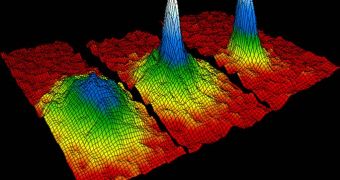Scientists at the Rice University were recently able to make impressive advancements in a field of research that is just beginning to take off, more than 40 years after its foundations were set. The team offers uncontroversial evidence to support the theory related to the existence of a universal quantum mechanism, which allows for the appearing and reappearing of trimers. The latter are groups of elementary particles that form when simple pairs cannot.
The mechanism also allows the trimers to appear again and again, only each time at higher energies than the last. According to the group, these particle triplets are able to do so infinitely. The evidence compiled to support their statements is the clearest in the matter ever created and already available for review in the latest online issue of the top journal Science. The work was made possible through the study of ultracold atoms, which were cooled below the average temperature that outer space has.
"It's such a remarkable phenomena. There are examples, like the Borromean rings, where having a third component is crucial. Any two of the rings will unbind if the third is removed, and these trimers are similar. The particles want to bind, but no two can do it. They need the third one to make it happen,” explains Rice expert Randy Hulet, the leader of the study team.
The first hypothesis related to the existence and behavior of trimers appeared more than 40 years ago, and it was the work of theoretical physicist Vitaly Efimov. Even with the limited scientific means at its disposal all those years ago, Efimov was able to predict that the effect underlying the triplets's actions would be both universal and repeating. The thing is that the scientific community seems to have a reluctance in accepting 3-body problems, and so the experts' work was frowned upon. As an interesting fact, the most basic such problem – the Earth-Sun-Moon problem – is still unanswered.
“You can do a numerical calculation, of course. You can calculate to arbitrary precision what the sun, Earth and moon are doing relative to one another at any given time, but you cannot write out a formula for that on paper. There is no general solution for that or any other three-body problem,” explains Hulet, who is also the university’s Fayez Sarofim Professor of Physics and Astronomy.
“A lot of people didn't believe him [Efimov]. That's partly because physicists can handle two-body problems quite well and many-body problems fairly well, but when there are just a few objects, like the three bodies in these Efimov trimers, there are just too many variables,” the expert adds. He reveals that, when he presented the paper in Rome earlier this year, Efimov, now at Washington University, was in the room. “He was so excited that he came up and gave me a high five after the talk. In his original paper, he had a figure that looked just like what we had found. It was such an amazing prediction, and to see it borne out like this is very special,” Hulet concludes.

 14 DAY TRIAL //
14 DAY TRIAL //